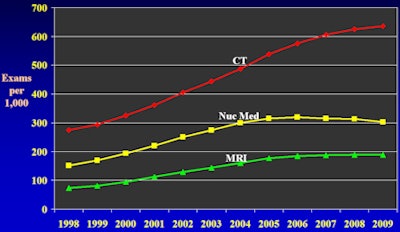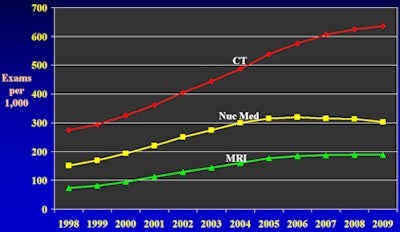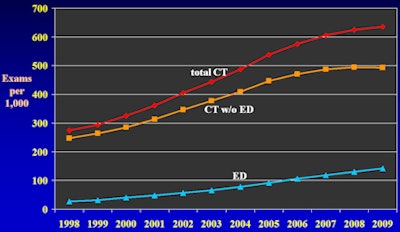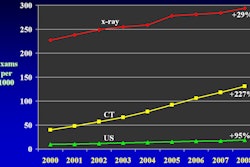
Emergency departments are major drivers of the recent explosion in CT utilization -- in fact, without emergency department use, CT utilization rates would have stayed almost flat in recent years, according to researchers at Thomas Jefferson University Hospitals.
CT has been one of the fastest-growing medical imaging modalities in the past decade in the U.S., driven by the technology's ubiquity and cost advantage over more expensive modalities such as MRI. This rapid growth has generated widespread concern, however, due to fear that unnecessary CT utilization could be exposing patients to excess radiation dose while also increasing healthcare costs.
At the recent RSNA 2011 meeting, Dr. David C. Levin presented research he and colleagues conducted to determine the role that emergency departments have played in the growth in CT utilization. Use of CT has continued to increase since 2006, even though the growth of modalities such as MRI and nuclear medicine has flattened.
"While utilization growth in MRI and nuclear medicine has stopped, growth continues in CT," Levin told session attendees. "Our data show that of the four primary places of service where imaging is performed, the emergency department is the only one where substantial CT growth is still occurring."
Levin's team used information culled from Medicare Part B databases for 1998 through 2009, particularly checking place-of-service codes for four major care settings where imaging is performed: hospital inpatient settings, hospital outpatient facilities, private offices, and emergency departments.
Across all four settings, the Medicare CT utilization rate increased from 274 per 1,000 in 1998 to 636 per 1,000 in 2009; the modality's compound annual growth rate was 9.7% from 1998 to 2006 and then 3.4% between 2007 and 2009.
 |
| Medicare overall utilization rates of CT, MRI, and nuclear medicine (including PET), all locations. All images courtesy of Dr. David C. Levin, Thomas Jefferson University Hospitals. |
Meanwhile, in emergency departments, utilization rates of CT rose from 27 per 1,000 in 1998 to 143 per 1,000 in 2009. By care setting, the 1998 to 2006 CT compound annual growth rates were as follows:
- Emergency departments: 18.6%
- Physician offices: 15.2%
- Hospital inpatient settings: 7.3%
- Hospital outpatient facilities: 7%
 |
| Medicare utilization rate of CT, less emergency department (ED) rate, 1998 to 2009. |
From 2007 to 2009, the compound annual growth rates for CT in all four places of service dropped. This was in line with an overall slowdown in the use of advanced diagnostic imaging services as healthcare providers presumably responded to Medicare reimbursement cuts such as the Deficit Reduction Act of 2005. However, emergency room CT still recorded double-digit annual growth rates:
- Emergency departments: 10.5%
- Physician offices: 3.1%
- Hospital inpatient settings: 1.4%
- Hospital outpatient facilities: 1.2%
The numbers led Levin's group to surmise that if emergency department rates were not included in utilization calculations for CT, the modality's annual growth would have remained even.
"The important finding in this study is that CT growth is still occurring in the emergency department setting; its use isn't really growing any more in hospital inpatient settings, hospital outpatient facilities, or private offices," Levin told AuntMinnie.com. "It can be hard to control CT growth in emergency departments, where patients are often acutely ill and triage has to be done quickly and accurately. But I think radiologists are doing a good job of helping to control utilization in those other three settings."




















